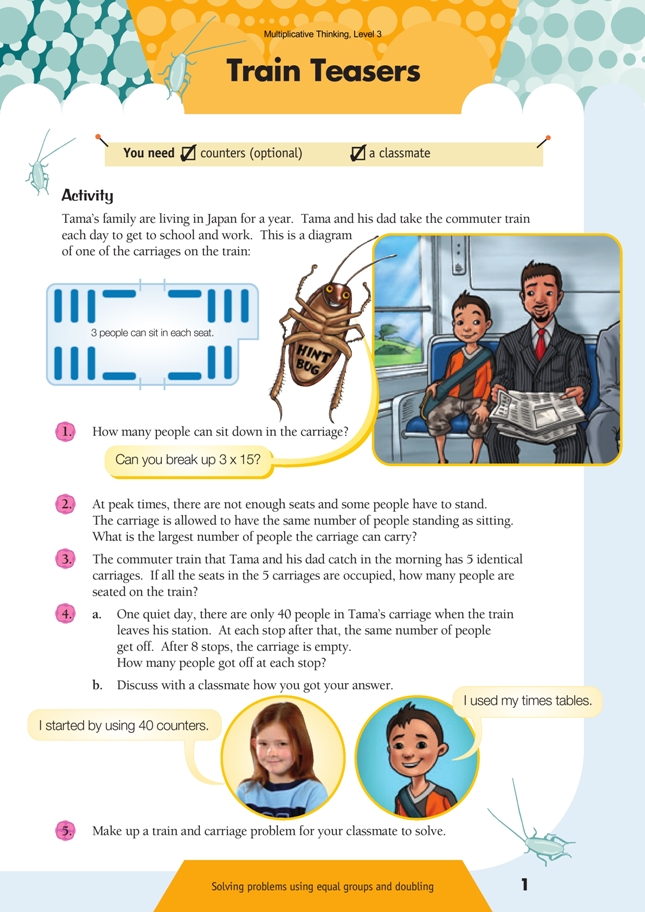This is a level 3 number activity from the Figure It Out series. It relates to Stage 6 of the Number Framework.
A PDF of the student activity is included.
Click on the image to enlarge it. Click again to close. Download PDF (614 KB)
solve mutliplication problems by deriving from 5 times tables
explore strategies such as place value and tidy numbers to solve multiplication
Number Framework Links
Use this activity:
• in a guided instruction situation, to practise multiplication by repeated addition (stage 5)
• to develop your students’ ability to derive unknown multiplication facts by applying their addition and subtraction strategies to multiplication facts they already know (stage 6)
• as an independent activity for students already using advanced additive strategies (stage 6).
FIO, Level 3, Multiplicative Thinking, Train Teasers, page 1
A classmate
You can use this activity to encourage your students to use a combination of known facts and mental strategies to derive answers to multiplicative problems. Key mathematical concepts to focus on are:
• multiplication and division involve making equal groups and then working with those groups to speed up counting
• unknown multiplication facts can be derived from facts that students already know, by applying addition and subtraction strategies. Students need to know their 5 times and 10 times basic facts in order to use stage 6 thinking and derive answers from those facts in this activity.
Vocabulary that you may need to discuss when introducing the activity:
• commuter: a person who travels some distance to and from work
• peak times: busiest times
• identical: exactly the same.
For question 1, encourage students who are transitioning to stage 6 to look for alternative ways of grouping and counting 3 x 15 rather than just skip-counting in threes or adding 15 + 15 + 15. This could be done by using counters and blocks to represent the people on each seat and then arranging and grouping them in different ways to make them quicker to count or by using place value materials such as canisters and beans.
Possible multiplicative strategies include:
• working out 3 lots of 15 rather than 15 lots of 3. This requires students to understand that changing the order of the factors gives the same result (the commutative property of multiplication).
• breaking up the 15 seats into smaller groups and then using known facts to work out those groups: (3 x 10) + (3 x 5) = 30 + 15 = 45. This strategy requires students to use the distributive property of multiplication over addition: the sets of 15 are distributed into sets of 10 and 5.
Question 3 provides another opportunity for your students to work multiplicatively rather thanadditively; in this case, viewing the problem as 5 x 45 rather than 45 + 45 + 45 + 45 + 45. You can encourage this by asking them to think of alternative ways they could break up the groupings of 45 to make them quicker to count. Place value materials could be used to represent the 5 lots of 45:
Possible multiplicative strategies include:
• Using place value partitioning to split the 45 into 40 + 5 and then working out (5 x 40) + (5 x 5). The students could use known facts to solve 5 x 40. You could prompt them by asking: There are 5 groups of 4 canisters. How many canisters are there altogether? How many beans would there be in 20 canisters (20 tens)?
• Breaking 45 into 10 + 10 + 10 + 10 + 5 and then using easier multiplication facts to solve the problem: (5 x 10) + (5 x 10) + (5 x 10) + (5 x 10) + (5 x 5).
How your students solve question 4 will depend on what basic facts that they already know. Prompt them to use those facts by asking: Do you know any multiplication facts that have 40 and 8 in them? How could you use that fact to solve this problem? Students who do not know that 40 ÷ 8 = 5 or 5 x 8 = 40 may need to use repeated subtraction and/or materials. Encourage these students to make the link between repeated subtraction and division by discussing the meaning of the ÷ symbol
(“share into sets/groups of”) and asking them how they could record what they did by putting numbers into the boxes: people shared into groups makes in each group, ÷ = (for example, 40 ÷ 8 = 5).
For question 5, encourage the students to make up both “groups of” (multiplication) problems and “sharing” (division) problems. Remind them that they have to be able to solve and explain the solutions to their problem themselves. This makes it unlikely that they will use numbers that are unfriendly for mental calculations and numbers that cannot be shared without remainders.
Answers to Activity
1. 45. (A multiplicative strategy is to break the 15 into smaller groups and then use known facts. For example: [3 x 10] + [3 x 5] = 30 + 15 = 45.)
2. 90. (Using place-value partitioning, 45 + 45 = [40 + 40] + [5 + 5] = 80 + 10 = 90.)
3. 225. (A multiplicative strategy is to break the 45 into smaller groups and multiply each group by 5. For example, 5 x [40 + 5] is [5 x 40] + [5 x 5] = 200 + 25 = 225. Another way to break up 45 is 10 + 10 + 10 + 10 + 5. So 5 x 45 = [5 x 10] + [5 x 10] + [5 x 10] + [5 x 10] + [5 x 5] = 50 + 50 + 50 + 50 + 25 = 225.)
4. a. 5
b. Methods will vary. If you know that 5 x 8 = 40, you could use this to solve
40 ÷ 8 = .
5. Problems will vary.

